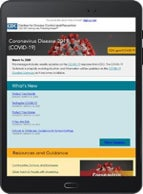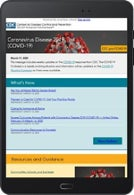Fighting COVID-19: How CDC is delivering critical information

Centers for Disease Control and Prevention uses Adobe Analytics and Adobe Campaign to deliver critical information to people. Image source: Adobe Stock.
The spread of the coronavirus (COVID-19) throughout the world has drastically changed our society. To manage our businesses, organizations and daily lives, people need accurate, timely information and guidance as new developments emerge about the pandemic.
Assisting in the fight against COVID-19 is the nation’s health protection agency, the Centers for Disease Control and Prevention (CDC). With a staff of more than 10,000, CDC is tasked with addressing consumer health and safety threats and sharing that critical information with the public.
To do so, CDC leveraged Adobe Experience Cloud (with Adobe Analytics and Adobe Campaign) to ensure that detailed and actionable insights are delivered on a timely basis — and with more personalization into website engagement on CDC.gov.
A new level of information demand
Prior to COVID-19, CDC saw an average of 3.2 million-page views per day. That doesn’t compare to the surge of website traffic that hit the agency in early 2020 when COVID-19 became a pandemic. By late February, the agency’s website traffic went up to 22 million average page views per day. Then in March, the daily average page views grew to 65 million, and the total number of page views for the entire month exceeded more than one billion.
Recognizing that a demanding constituent base was growing and needed timely information, CDC required better analytics and communications to determine the information millions of people wanted as well as how to proactively send it to them. The agency turned to an array of solutions including Adobe Analytics.
Adobe Analytics provided key insights for content creation
Adobe Analytics provided CDC with a number of solutions, including ad hoc and scheduled reporting, an analysis workspace and a data warehouse. Using “high water” alerts and daily Adobe Analytics predictions, the agency was able to access valuable insights and take action — producing the right content at the right time using terminology that works. At the onset of the pandemic, CDC started with 10 web pages. By the fall of 2020, the agency had more than 1,000 web pages — all based on specific audience needs.
The demand for up-to-date information regarding COVID-19 has generated a substantial increase in email subscriptions. CDC recognized that their email subscriber list would continue growing in the coming weeks and months, so with a sense of urgency, the agency turned to Adobe to streamline workflows and leverage analytics to ensure that information was being communicated to millions of people — while improving outreach based on reader interest.
Better and faster communication
CDC uses Adobe Campaign to deliver a consistent message across multiple channels, including their website, email, text message, direct mail and social media platforms. One of the key benefits of Adobe Campaign is that it helps communications teams create their own campaigns and adjust workflows and audience segment lists without involving IT departments.
Like many organizations, CDC sends out a weekly email and uses analytics to better understand the interests of their audience and create content to match expectations. The bottom line — with better insight and an easier-to-use multichannel communication tool, CDC is able to send more relevant and timely email communications to keep people informed.
Today, more than 2 million people receive up-to-date information related to COVID-19 via email, SMS text and newsletter subscriptions.
CDC also saves time by using out-of-the-box templates from Adobe Campaign that can be customized and saved for reuse. Templates ensure that information is delivered in an easy-to-digest 508 (accessibility standard) format. Adobe Campaign makes it possible to modify content quickly without having to manually code every email in HTML.
Best practices for government agencies
Through this experience, CDC has learned valuable takeaways that others in federal, state and local governments should consider.
Website Analytics
- Set baselines and high-water marks or records for key metrics, such as page views and unique visitors. Consider which events create spikes in traffic and note the most popular online requests.
- Be ready to handle additional metrics, beyond baselines and high-water marks, and consider worst-case scenarios.
- Build internal and external communications and establish partnerships and relationships with as many key groups as possible.
- Know the tools and the data sources that are reliable in a challenge. Test your systems and your processes under simulated scenarios to ensure they will not break under pressure.
- Set alerts or triggers for serious trends as they emerge so that you can act quickly.
- Analyze content to determine low or high engagement. Also check the navigation paths to the content and keyword search tags and verify the titles and subtitles to make sure they are relevant.
To help government agencies, here is some guidance from the workflow process and examples of CDC emails around COVID-19:
- Create branded templates that provide a familiar, user-friendly structure for readers and are easy to quickly update.
- Prompt new readers to subscribe. Include a notice of subscription status at the top of the email.
- Give subscribers options. Let readers select which topics to follow, the level of email frequency and the language preference and delivery method (such as text alerts combined with email subscriptions).
- Optimize publishing frequency and content. With analytics and email working together, publishers can determine which times or days’ work better for sending content to the targeted audience and which content has better click-through rates to the website.
- Utilize cross-platform engagement reporting. With a combined view of content consumption versus silos of systems for websites, mobile apps, and email, content owners know which content is working and which is not — across the board.
Click on each image to view PDFs of two different CDC emails.
To get the latest information about COVID-19 and subscribe to the Centers for Disease Control and Prevention COVID-19 newsletter, visit their website or social media channels below.

